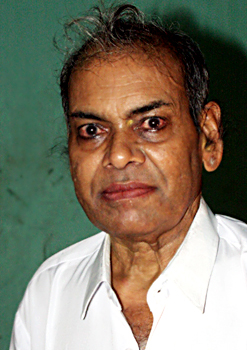 Kalamandalam Vasu Pisharody is a popular name in the realm of Kathakali Dance. He is a well known disciple of Padma Shri Vazhenkada Kunchu Nair. This particular Kathakali dancer is known for his anti-hero performances and his roles as semi-realistic minukku. He has also excelled as a virtuous pachacha. Some of his masterpiece performance has been the roles of Nalan, Bahukan, Arjuna, Bhima, Yudhisthir, Rukmangadan and Brahmanan.
Kalamandalam Vasu Pisharody is a popular name in the realm of Kathakali Dance. He is a well known disciple of Padma Shri Vazhenkada Kunchu Nair. This particular Kathakali dancer is known for his anti-hero performances and his roles as semi-realistic minukku. He has also excelled as a virtuous pachacha. Some of his masterpiece performance has been the roles of Nalan, Bahukan, Arjuna, Bhima, Yudhisthir, Rukmangadan and Brahmanan.
Vashu Pisharody was born on August 15th in 1943 at the Pallakad District. Soon after schooling he was enrolled under the guidance of Balakrishnan Nair at Kerala Kalalayam. After some time Pisharody had joined PSV Natyasangham for further training and had remained a trainee there for a period of three years. Finally he joined Kerala Kalamandalam where he carried on his further studies for a period of six years. Pisharody in the course of his career had remained the student of Ramankutty Nair and Kalamandalam Padmanabhan Nair.
In the beginning Pisharody started his career at a kalari which was run by Guruvayur Kathakali club. In the year 1979 he once again had joined Kerala Kalamandalm and served the institutions for two long decades. Finally he retired as the vice-principal of the institute.
This famous dancer had graced several stages of Kerala and others with his marvelous performance. He was also honoured with Central Sangeet Natak Academy Award. Pisharody was also popular trainer of Kathakali dance and his well known disciples had been Kalamandalam Sreekumar and Kalamandalam Pradeep.
In the year 2005 ill health prompted Pisharody to take a break from his passion as well as profession but in the year 2009 in and around the month of March Pisharody once again made a graceful come back to the stage. After the period of break his first performance was at the Thirumandhamkunnu temple in his village of Kongad.
This article is a stub. You can enrich by adding more information to it. Send your Write Up to content@indianetzone.com



















